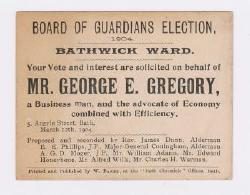George Gregory

George Edward Gregory (1852-1930) of Bath was president of what was then known as theInternational Association of Antiquarian Booksellersthrough the difficult years of the Great War between 1915 and 1918. He was born at Bath in 1852, the son of William Gregory, himself born and bred in Bath, and his wife Margaret, who came from Cardiganshire. William Gregory was a master bookbinder, then living at 14 York Street and employing two men.
By 1871, the family now living at 11 Prior Park Cottages, George Gregory was himself a bookbinder. In 1878 he married Isabel Marriott Clement, a pianist who had once lodged with another Bath bookbinder, John Maggs. The couple set up house at 1 Upper East Hayes Terrace, Walcot – their first and only child being born the following year. The 1881 Census entertainingly lists the occupation of two-year-old George Bernard Gregory as “little beggar”.
Gregory had widened the family business to include bookselling as well as bookbinding, and by 1888 or earlier he was in occupation of what were to become well-known premises at 5 Argyle Street, on the corner of Grove Street – the family living above the shop. In an 1894 advertisement he styled himself as an “English, Foreign, Colonial and General Book Merchant, Library Buyer and Exporter”, issuing monthly catalogues, and with “upwards of 100,000 volumes always on sale”. Active in local politics, he sought election to the Bath Board of Guardians in 1904 as “the advocate of economy combined with efficiency”.
The 1911 Census recorded him, still at Argyle Street, as a “bookseller (rare and antiquarian) by appointment to Queen Alexandra” and by now he was also issuing catalogues of prints. At about this time he also offered for sale his own extraordinary collection of illuminated manuscripts – “the diligent quest of a long life” – a collection he believed unmatched outside the British Museum and the Bodleian, and certainly the most remarkable collection ever offered by an antiquarian bookseller.

He remained at Argyle Street, still selling books and styling the shop “the world’s book store”, until 1923. His son had died quite young and the business, complete with a stock of books filling twenty-three rooms, was sold to George Bayntun in 1924. Gregory’s wife of over fifty years died in May 1930 and he did not long survive her, dying at the Forbes Fraser Hospital near Bath on the 1st August in the same year.
Laurence Worms, March 2013 - with thanks to Edward Bayntun-Coward for additional information and images.
